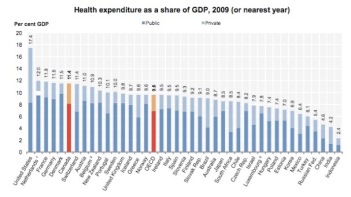The Supreme Court is about to decide the fate of the Affordable Care Act/ACA know as Obamacare.. We need to continue to consider how to modify this system as well as alternatives if the ACA gets voted as unconstitutional. After reviewing the Japanese healthcare system I thought that I would discuss our neighbor’s health care system next, Canada, because we spend so much time talking about this other health care system in our debate. How is it different from our Affordable Care Act and can we learn anything form its advantages and disadvantages and should we here in the U.S. adopt their system? Canada’s health care system is a group of socialized health insurance plans that provides coverage to all Canadian citizens. It is publicly funded and administered on a provincial or territorial basis, within guidelines set by the federal government.
The Canadian health care system was built around the principle that all citizens will receive all “medically necessary and hospital and physician services.” Each of Canada’s 10 provinces and three territories finance and run statewide health insurance program. Under the health care system, individual citizens are provided preventative care and medical treatments from primary care physicians as well as access to hospitals, dental surgery and additional medical services. With a few exceptions, all citizens qualify for health coverage regardless of medical history, personal income, or standard of living.
Canada’s health care system is the subject of much political controversy and debate in their own country. Some question the efficiencies of the current system to deliver treatments in a timely fashion, and advocate adopting a private system similar to the United States. Conversely, there are worries that privatization would lead to inequalities in the health system with only the wealthy being able to afford certain treatments.
Regardless of the political debate, Canada does boast one of the highest life expectancies (about 80 years) and lowest infant morality rates of industrialized countries, which many attribute to Canada’s health care system.
Canada Health Act
The Canada Health Act is federal legislation that puts in place conditions by which individual provinces and territories in Canada may receive funding for health care services.
There are five main principles in the Canada Health Act:
- Public Administration: All administration of provincial health insurance must be carried out by a public authority on a non-profit basis. They also must be accountable to the province or territory, and their records and accounts are subject to audits.
- Comprehensiveness: All necessary health services, including hospitals, physicians and surgical dentists, must be insured.
- Universality: All insured residents are entitled to the same level of health care.
- Portability: A resident that moves to a different province or territory is still entitled to coverage from their home province during a minimum waiting period. This also applies to residents, which leave the country.
- Accessibility: All insured persons have reasonable access to health care facilities. In addition, all physicians, hospitals, etc., must be provided reasonable compensation for the services they provide.
Provincial Health Insurance
The individual provinces and territories handle health insurance in Canada. New residents to a particular province must apply for health coverage. Upon being granted health coverage, a health card is issued which provides coverage in that particular province or territory.
For new residents, there are typically waiting periods before health coverage will be granted. This can vary, but cannot exceed three months as part of the Canada Health Act.
Certain provinces (British Columbia, Alberta, and Ontario) require health care premiums for services. Under the Canada Health Act, however, health services cannot be denied due to financial inability to pay premiums.
In addition to standard health coverage as described in the Canada Health Act, provinces typically provide additional services. These can include physiotherapy, dental coverage, and prescription medicines. Provinces are not obligated to provide services not listed in the Canada Health Act, and such services can be affected by changing government policies.
Private Health Insurance
While the health care system in Canada covers basic services, including primary care physicians and hospitals, there are many services that are not covered. These include things like dental services, optometrists, and prescription medications.
Private health insurance plans are usually offered as part of employee benefit packages in many companies. Incentives usually include vision and dental care. Alternatively, Canadians can purchase insurance packages from private insurance providers. In fact, about two-thirds of Canadians take out private, supplemental insurance policies (or have an employer-sponsored plan) to cover the additional services. The main reason many choose to purchase private insurance is to supplement primary health coverage. For those requiring services that may not be covered under provincial health insurance such as corrective lenses, medications, or home care, a private insurance plan offsets such medical expenses.
While private insurance can benefit those with certain needs, many Canadians choose to rely exclusively on the public health system.
It is interesting that while Canada is traditionally thought of as a publicly financed system, spending on these supplemental benefits means that 30 percent of health spending comes from private sources. One 2011 study found that nearly all Canadian spending on dental care came from non-government dollars, 60 percent covered by employer-sponsored plans and 35 percent paid out of pocket. Some Canadian legislators have made pushes to increase the scope of Canada’s public health plan, to cover more services, but have so far proved unsuccessful.
Public Health Care Providers
Under the Canada Health Act, primary care doctors, specialists, hospitals and dental surgery are all covered by provincial insurance policies.
Primary care physicians are the forefront of Canadian health care. There are currently about 30000 primary care doctors in Canada, and they account for just over half of all physicians. They provide basic medical treatments and preventative care.
Specialists are provided for services outside the scope of primary care physicians. Typically, an individual’s physician will refer them to specialists as needed. There are currently about 28000 specialist doctors working in Canada.
Hospitals operate both with referrals from physicians as well as on an emergency basis. Ambulatory services are provided for those unable to transport themselves to a hospital in the event of an emergency.
Private Clinics
In addition to public health care providers such as primary care doctors and hospitals, many private clinics offering specialized services also operate in Canada.
Under federal law, private clinics are not legally allowed to provide services covered by the Canada Health Act. Regardless of this legal issue, many do offer such services.
The advantage of private clinics is that they typically offer services with reduced wait times compared to the public health care system. For example, obtaining an MRI scan in a hospital could require a waiting period of months, whereas it could be obtained much faster in a private clinic.
Private clinics are a subject of controversy, as some feel that their existence unbalances the health care system and favors treatments to those with higher incomes.
Costs in private clinics are usually covered by private insurance policies, which will typically pay around 80% of the costs.
Accessing Health Care
Accessing Canada’s health care system involves first applying for a provincial health card. Excluding inmates, the Canadian Armed Forces and certain members of the RCMP, the Canada Health Act requires all residents of a province or territory to be accepted for health coverage. There is a waiting period in place for new immigrants that cannot exceed three months.
Once a health card is assigned, it is used whenever visiting a physician or health care provider. The health card contains an identification number, which is used to access a person’s medical information.
After obtaining health coverage, one can register with a primary care physician. For routine visits to a physician, one needs only present their health card. There are typically no forms to be filled out or individual service fees.
The availability of physicians depends largely on the number of doctors and the current demand for medical services. Currently there is about 1 primary care doctor for every 1000 Canadians.
Health Care Funding
Health care in Canada is funded at both the provincial and federal levels. The financing of health care is provided via taxation both from personal and corporate income taxes. Some provinces also use additional funds from other financial sources like sales tax and lottery proceeds.
Alberta, British Columbia, and Ontario also charge health premiums to supplement health funding, but such premiums are not required for health coverage as per the Canada Health Act.
At a federal level, funds are allocated to provinces and territories via the Canadian Health and Social Transfer (CHST). Transfer payments are made as a combination of tax transfers and cash contributions. The amount of funding provinces and territories receive is significant, and topped $35 billion in 2002-2003.
In 2000, the new budget injected an additional $23 billion of investment into the health care system.
Health Care and the Economy
Canada’s health care has a large impact on the Canadian economy. Here are a few facts and figures about the economy and health care:
- Health care expenditures in Canada topped $100 billion in 2001.
Approximately 9.5% of Canada’s gross domestic product is spent on health care. In 2009, Canada spent 11.4 percent of its Gross Domestic Product on health care, which puts it on the slightly higher end of OECD countries:
- In comparison, the United States spends close to 14% of its GDP on health care.
- Individually, Canadians spend about $3300 per capita on health care.
- At a provincial level, funding is between one-third and one-half of what provinces spend on social programs.
- About three-quarters of all funding comes from public sources, with the remainder from private sources such as businesses and private insurance.
Health Care and Politics
One of the forefronts of debate in Canadian politics is its health care system. There are many factors in the debate, but some key issues are:
Federal involvement in health care: Because provinces and territories are responsible for the actual administration and delivery of health care in Canada, friction is apparent whenever policies are set at a federal level.
Private health care: While privately funded clinics do provide certain services with shorter wait times than the public system, there are those who object to any privatization of the health system. The arguments are that a “two-tier” health care system will unbalance the system and favor those with higher incomes.
The shortage of doctors and nurses in Canada: Some feel that Canada’s health care system does not adequately compensate health care providers. This has led to a “brain drain” of Canadian doctors and nurses, which have left Canada to pursue careers in the United States. Attracting and keeping skilled medical workers is a priority if Canada is to be able to provide proper medical services. We will discuss the problems in another post.
To review, Canadian healthcare basically works like Medicare, but for everyone. Medical care is free, and it covers almost everything other than prescription drugs, glasses, and dental care. (Most people have supplementary insurance to cover those things). It keeps its drugs cheap by negotiating at a federal level with pharmaceutical companies.
Let’s review the two other parts of the equation next week, the education of the physicians as well as the malpractice issues. Do they offer any suggestions to the ACA or whatever is on the horizon here in the U.S.?

